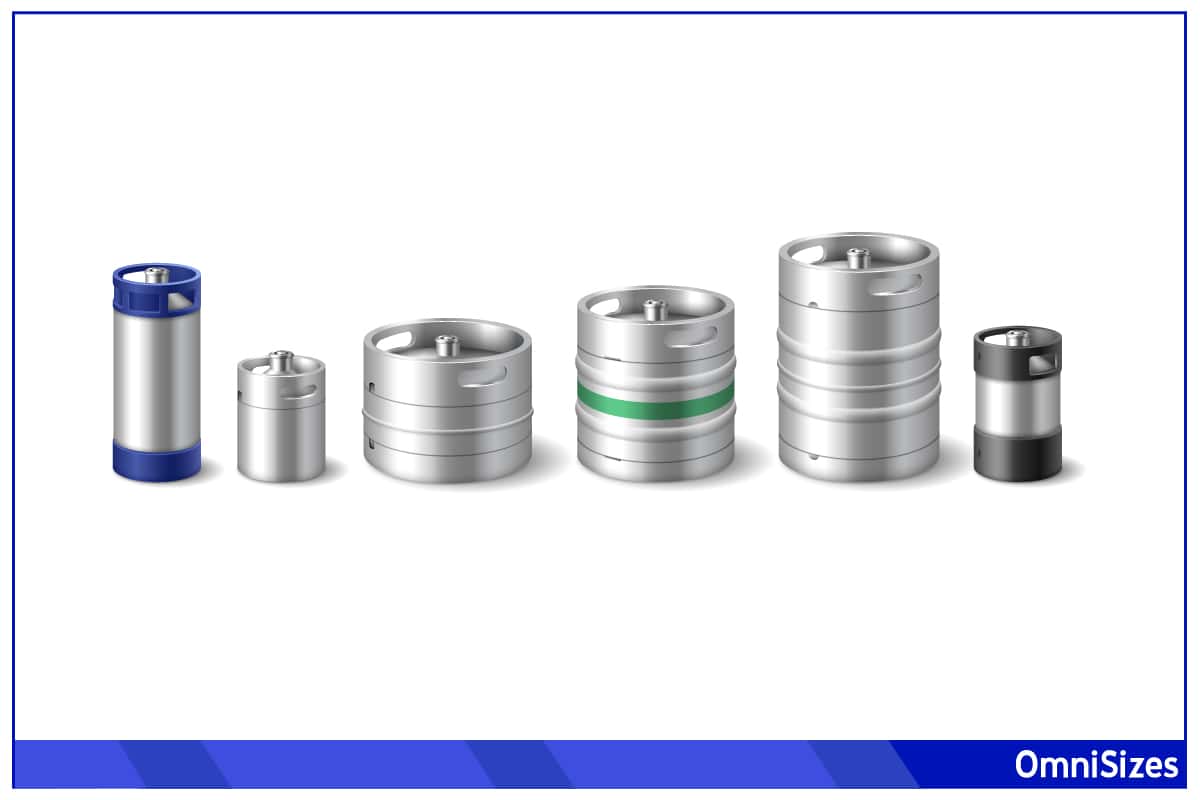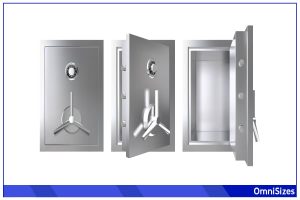Kegs are an essential part of the brewing and beverage industry that come in various keg sizes. From small gatherings to large-scale events, the right keg size ensures that every glass poured is fresh and flavorful.
Common keg sizes include:
- Cornelius keg: 5 gallons, 23 × 9 inches
- Sixth Barrel: 5.16 gallons, 23-3/8 × 9-1/4 inches
- Quarter Barrel: 7.75 gallons, 13-7/8 × 16-1/8 inches
- Slim Quarter Barrel: 7.75 gallons, 23-3/8 × 11-1/8 inches
- Half Barrel: 15.5 gallons, 23-3/8 × 16-1/8 inches
- 50-liter: 13.2 gallons, approx. 20 × 16 inches
- Mini: 1.32 gallons, 9-7/8 × 6-3/4 inches
This guide will describe the evolution of kegs, as well as their types and sizes in more detail. If you’d also like to learn how to use a keg for the first time, this guide will explain how.
Evolution of Kegs
Kegs have a rich history, evolving from simple wooden barrels to the high-tech vessels we see today. This journey mirrors the progress in brewing and beverage dispensing.
The story of kegs begins with wooden barrels, used for centuries to store and transport various liquids, including beer. These barrels were made from wood staves and bound with metal hoops. The wood added unique flavors to the beer, a characteristic cherished by many even today. However, wooden barrels had limitations: they were heavy, prone to leakage, and difficult to clean and maintain.
The shift to metal kegs began in the early 20th century. These kegs, initially made from steel and later from lighter materials like aluminum, addressed many of the shortcomings of wooden barrels. Metal kegs were more durable, easier to clean, and better at preserving the quality of the beer.
Types of Kegs and Sizes
Kegs come in various types and sizes, with each being suited for specific drinking needs.
Standard Kegs
The most commonly used kegs are the standard types, known for their reliability and wide acceptance across the industry. These include:
- Cornelius Keg: Holds 5 gallons, measuring 23 × 9 inches (58.42 × 22.86 cm). Popular among homebrewers for its manageable size and ease of use.
- Sixth Barrel: Contains 5.16 gallons, with dimensions of 23-3/8 × 9-1/4 inches (59.37 × 23.50 cm). A common choice for small-scale craft breweries and bars offering a diverse beer selection.
- Quarter Barrel: Known as a “pony keg,” it has a capacity of 7.75 gallons and measures 13-7/8 × 16-1/8 inches (35.24 × 40.96 cm). Ideal for medium-sized gatherings or bars with limited space.
- Slim Quarter Barrel: Also 7.75 gallons, but with a slimmer profile at 23-3/8 × 11-1/8 inches (59.37 × 28.26 cm), making it a space-efficient option.
- Half Barrel: The most familiar size, often referred to as a “full-size keg,” holding 15.5 gallons and measuring 23-3/8 × 16-1/8 inches (59.37 × 40.96 cm). The standard in large events and mainstream beer distribution.
Specialty Kegs
In addition to standard types, there are specialty and international kegs:
- 50-liter Keg: Common in Europe, holds 13.2 gallons, approximately 20 × 16 inches (50.80 × 40.64 cm). It’s a versatile size, bridging the gap between small and large kegs.
- Mini Keg: Perfect for personal use, it holds 1.32 gallons and measures 9-7/8 × 6-3/4 inches (25.08 × 17.15 cm). Often used for special brews or as a sampler.
Keg Sizes Summary Table
| Keg Type | Capacity in Gallons | Capacity in Pints | Dimensions in Inches | Best Use |
| Cornelius Keg | 5 | 40 | 23 × 9 | Home brewing |
| Sixth Barrel | 5.16 | 41.28 | 23-3/8 × 9-1/4 | Small craft breweries, diverse beer bars |
| Quarter Barrel | 7.75 | 62 | 13-7/8 × 16-1/8 | Medium gatherings, limited space bars |
| Slim Quarter Barrel | 7.75 | 62 | 23-3/8 × 11-1/8 | Space-efficient bars, events |
| Half Barrel | 15.5 | 124 | 23-3/8 × 16-1/8 | Large events, mainstream beer distribution |
| 50-liter Keg | 13.2 | 105.6 | Approx. 20 × 16 | Versatile use, bridge between small/large |
| Mini Keg | 1.32 | 10.56 | 9-7/8 × 6-3/4 | Personal use, special brews, samplers |
How to Use a Keg
Using a keg for storing and serving beer might seem daunting, but it’s quite straightforward once you know the basics. This section will guide you through the essentials of keg usage, from tapping to serving.
1. Setting Up Your Keg
Before you start pouring, you need to set up your keg properly. First, make sure the keg is chilled. Beer served from a keg should be cold, so store your keg in a cool place for several hours before use. Once chilled, place the keg in a stable position. If you’re using a keg for a party, consider a keg tub to keep it cool throughout the event.
2. Tapping the Keg
Tapping a keg is the process of attaching a keg coupler to it. Start by locating the valve on top of the keg. Remove the cap, and then attach the coupler by pushing it down onto the valve and twisting it to lock. This process varies slightly depending on the type of keg and coupler, so check the manufacturer’s instructions.
3. Connecting to a CO2 Tank
Most kegs require a CO2 tank to push the beer out and maintain its carbonation. Connect your CO2 regulator to the CO2 tank, then attach the gas line from the regulator to the coupler on the keg. Set the CO2 pressure following the beer type recommendations—usually between 10-14 PSI for most beers.
4. Pouring the Beer
To pour, open the tap by pulling the handle. Pour beer into a tilted glass to reduce foam, straightening the glass as it fills. If the beer is too foamy, check your CO2 pressure and the temperature of the beer.
5. Handling and Safety
Always handle a keg with care. They’re heavy and can be hazardous if mishandled. Never shake or drop a keg, and be cautious of the pressure inside. Also, keep the keg away from heat sources to prevent pressure build-up.
6. Cleaning and Maintenance
After use, it’s crucial to clean your keg and the dispensing equipment. This ensures the beer remains fresh and tastes good for the next use. Clean the keg coupler, beer lines, and faucet with appropriate cleaning agents and rinse thoroughly.
7. Storing the Keg
If you have leftover beer, you can store the tapped keg for a short period. Keep it refrigerated and maintain the CO2 pressure to keep the beer fresh. Usually, a tapped keg can last up to a few weeks if stored correctly.






